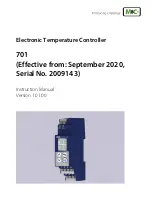
Setup
Connections
EPOS4 Disk 60/8 Hardware Reference
3-22
CCMC | 2021-10 | rel10276
Table 3-14
Power supply requirements
Table 3-15
Logic supply requirements
1)
Use the following formula to calculate the required voltage under load.
2)
Choose a power supply according to the calculated voltage. Thereby consider:
a)
During braking of the load, the power supply must be capable of buffering the recovered
kinetic energy (for example, in a capacitor).
b)
If you are using an electronically stabilized power supply, make sure that the overcurrent pro-
tection circuit is configured inoperative within the operating range.
c)
The maximal power supply vV
CC
must be equal or greater than the holding brake
supply voltage.
The formula already takes the following into account:
• Maximum PWM duty cycle of 90%
• Controller’s max. voltage drop of 1 V @ 8 A
KNOWN VALUES:
•
Operating torque M [mNm]
•
Operating speed n [rpm]
•
Nominal motor voltage U
N
[Volt]
•
Motor no-load speed at U
N
; n
O
[rpm]
•
Speed/torque gradient of the motor
Δ
n/
Δ
M [rpm/mNm]
SOUGHT VALUE:
•
Supply vV
CC
[Volt]
SOLUTION:
Power supply requirements
Output voltage
+V
CC
12…60 VDC
Absolute output voltage
min. 10 VDC; max. 61 VDC
Output current
Depending on load
• continuous max. 8 A
• short-time (acceleration, <10 s) max. 24 A
Logic supply requirements (optional)
Output voltage
+V
C
12…60 VDC
Absolute output voltage
min. 10 VDC; max. 61 VDC
Min output power
P
C
min. 3.5 W
V
CC
U
N
n
O
-------
n
Δ
n
Δ
M
---------
M
⋅
+
1
0.9
-------
⋅
⋅
1
V
[ ]
+
≥
















































